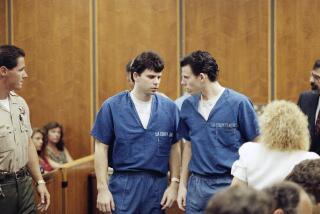Manson Follower to Get Hearing on Bid to Be Freed
- Share via
SACRAMENTO — They were bone-chilling crimes, sensational murders that spread fear through Los Angeles and turned their mastermind into a criminal antihero familiar to the world.
Charles Manson and four of his followers were convicted in the 1969 killings and have been in prison ever since. But now one of them has persuaded a judge to hear her claim that she is rehabilitated and deserves to be freed.
San Bernardino County Superior Court Judge Bob N. Krug has scheduled the hearing for Leslie Van Houten next month and ordered her to appear in court. The ruling has buoyed supporters who have long fought for Van Houten’s freedom and had thought her request might be denied outright.
“I’m glad to see the court system seems to have the courage to look beyond” the Manson label, said Van Houten’s attorney, Christie Webb. “She’s an individual entitled to consideration outside of the mythology that has grown up around this case.”
But lawyers for the state--along with relatives of the victims and Los Angeles County prosecutors--continue to oppose Van Houten’s parole. The Manson crimes were so heinous, they say, that they warrant her continued custody.
Van Houten was convicted of murder in the Aug. 10, 1969, stabbings of Leno and Rosemary LaBianca at their Los Feliz home. The murders came a day after other members of the Manson “family” killed pregnant actress Sharon Tate and four friends at Tate’s rented home in Benedict Canyon.
The murders--accented with messages scrawled on walls with the victims’ blood--captured national attention and ultimately made Manson, a lifelong con who orchestrated the killings, California’s most notorious criminal.
Van Houten, the youngest of Manson’s followers, has long been viewed as the least culpable of the group. A devoted band of supporters argue that she was a misguided teenager when she joined Manson’s commune, and that she was brainwashed by him and on LSD the night of the murders.
In 1982, Van Houten’s backers presented the parole board with 900 signatures urging her release. Three years later, she appeared on the cusp of winning parole when the chairman of her hearing panel told her she was “much closer than she might realize” to going home.
Since then, however, she has been back to the parole board and rejected seven more times, with the Los Angeles County district attorney’s office and relatives of the LaBiancas repeatedly opposing her release.
Van Houten is now 52, with long graying hair. Recently, she embarked on a route that has proven promising for other, less famous prisoners--filing a legal challenge that claims the parole board has unlawfully denied her freedom.
In court documents, Van Houten’s attorneys say she should be freed because she has been declared no longer dangerous by a prison psychiatrist, has displayed exemplary behavior during three decades of incarceration and has met other requirements set by authorities.
The “one apparently insurmountable obstacle” blocking her parole, her lawyers argue, is “that she was part of the Manson ‘Family.’ ”
Rather than focus a “myopic concentration on the crime,” the attorneys urge, the parole board should consider, “Who is Leslie Van Houten today?” She is, they contend, “completely rehabilitated, a shining example of the best results possible in our correctional system.”
In opposing Van Houten’s petition, the state attorney general argues that the parole board fulfilled its legal obligation to give her case “due consideration” before rejecting parole at her last hearing, in June 2000.
At that hearing, the board concluded that Van Houten would pose “an unreasonable risk of danger to society” if released and called her offense “especially cruel and callous.” Members added that Van Houten “needs additional time to gain . . . further insight into her involvement in this crime.”
In an interview, Deputy Atty. Gen. Heather Bushman said the board weighed many factors in finding her unsuitable for parole but that the decision rested mostly on “the gravity of the offense.” In court papers, Bushman also said the board’s discretion over parole is “great, absolute and almost unlimited.”
A former homecoming princess from Monrovia, Van Houten for years declined to speak about her experiences as one of “Manson’s girls.” But last year, criminologist Karlene Faith published a book based on private letters from Van Houten, “The Long Prison Journey.”
That account says Van Houten met Manson when she was 19 and became swept up in the bizarre cult he controlled through drug use, manipulation, sexual abuse and isolation from the outside world.
In the tumultuous days of the 1960s, Van Houten had left home to “seek some enlightenment like so many other young people during that time,” attorney Webb said.
But Manson’s group, which settled on the Spahn Movie Ranch above Chatsworth, was a warped version of other communes preaching free love and acceptance. The murderous rampage that took the life of Tate--a rising movie star and the wife of director Roman Polanski--and four others was apparently part of a bizarre plan to trigger a race war known as Helter Skelter, a name taken from a Beatles song.
Three Trials for Role in LaBianca Killings
Van Houten was not present at the Tate murders. But Manson did bring her along the following night to the home of the LaBiancas, owners of a grocery store chain, picked at random.
While Charles (Tex) Watson stabbed Leno LaBianca, Van Houten and Patricia Krenwinkel held Rosemary LaBianca in another room, placing a pillowcase over her head. Watson then stabbed Rosemary LaBianca with a bayonet, and gave Van Houten a knife and ordered her to “do something,” court documents show. Van Houten testified that she stabbed the victim 14 to 16 times in the back, but believed she was already dead.
Van Houten went through three trials for her role in the LaBianca killings. The first led to her conviction and a death sentence, but was overturned on appeal because her lawyer disappeared before the verdict.
The second trial ended with a hung jury, and the third led to her murder conviction and sentence of seven years to life with the possibility of parole. She is housed at the California Institution for Women in Chino.
Van Houten’s lawyers portray her record behind bars as that of a model prisoner, noting that she has obtained a bachelor’s degree, tutored other inmates, made quilts for homeless women and served as a leader in anti-drug programs and other self-help groups.
Whatever her accomplishments, the judge’s ruling on her petition is more likely to turn on his interpretation of law and regulations governing how the parole board decides whom to release.
If Krug rules in Van Houten’s favor, the parole board would hold another hearing, evaluating her case under guidelines set by the court.
Manson Denied Parole for the 10th Time
Van Houten’s lawyers say the board should follow language in the penal code stating that it “shall” grant parole unless public safety demands a more lengthy term. According to that logic, since Van Houten was judged no longer dangerous by a prison psychiatrist, she should be freed regardless of her past.
But the attorney general says the gravity of the crime can overshadow other factors suggesting someone is ready for release--so long as those other factors are examined by the board.
Manson, now 67, was denied parole for the 10th time Wednesday at Corcoran State Prison. He declined his first chance in five years to address the board, saying he did not want to be manacled for the appearance.
Prison officials said Manson has accumulated numerous disciplinary citations in recent years for offenses ranging from setting his mattress on fire to spitting on guards.
Also convicted in the slayings were Krenwinkel, Watson and Susan Atkins. All were initially sentenced to death, but had their sentences commuted to life imprisonment with the possibility of parole when the state Supreme Court abolished the death penalty. They remain in prison.
More to Read
Sign up for Essential California
The most important California stories and recommendations in your inbox every morning.
You may occasionally receive promotional content from the Los Angeles Times.










